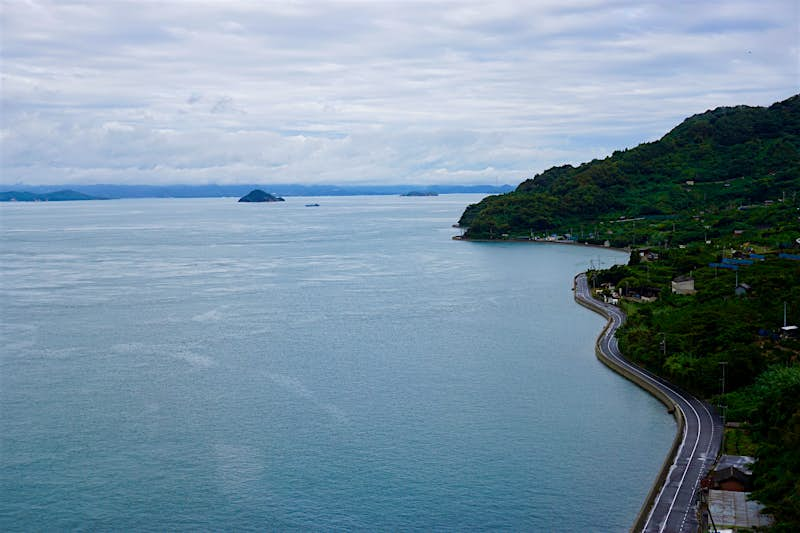Squeezed between Honshū, Shikoku and Kyūshū, three of Japan’s four main islands, the Seto Inland Sea is studded with hundreds of alluring smaller emerald green isles, which rise out of the seascape’s ever-present blue haze. The islands of the Seto Inland Sea have long been celebrated for their sublime beauty and, more recently, with the success of the Setouchi Triennale art festival, some have become places of pilgrimage for contemporary art lovers.
Those looking for a more energetic way to explore the region than cruising between islands by ferry can embark on an island-hopping adventure by bike. The Shimanami Kaido, a 70-kilometer (43-mile) cycle route that winds across six islands from Onomichi on Honshū to Imabari on Shikoku, is perhaps Japan’s best-known and most popular cycling route. But not too far away you can find a quieter, more off-the-beaten-path option: the Tobishima Kaido.
This 46-kilometer (29-mile) route crosses the Aki Nada Islands — an island chain in the Seto Inland Sea off the coast of Hiroshima Prefecture – via a chain of seven bridges. Although it’s less developed than the Shimanami Kaido, the Tobishima Kaido is clearly marked by blue-painted cycle lanes hugging the coastline. With a mild climate and gentle topography, the islands are ideal for cycling and, while the Shimanami Kaido is a busy expressway, you’ll likely encounter few cars on the Tobishima Kaido. While you can pedal the entire route within a few hours, the coastal scenery and seascapes merit slowing down, as do the art, architecture, cultural heritage and splendid beaches you can explore along the way.

Shimokamagari
From Kure in Hiroshima Prefecture, the 1,175-meter (3,850-foot)-long Akinada suspension bridge crosses the Seto Inland Sea to your first island in the Aki Nada chain, Shimokamagari. You can rent bicycles at the JR Nigata Station in Kure or cross over the sea to Shimokamagari by bus, ferry or foot and rent them there (there is no toll for bikes or pedestrians). Despite the bridge tethering it to Honshū, Shimokamagari feels a world away from the heart of modern, busy Japan, largely due to the presence of its rich history.
Set amongst picturesque gardens on the waterfront in the small town of Sannose, you can visit Shotoen Garden and Museums to learn about the elite Inland Sea mariners of the Edo period. Shimokamagari was an important port on the route through the Seto Inland Sea to Edo (now Tokyo) and when Korean envoys stopped here, they held lavish feasts, depictions of which you can see at the museum. Also on display is a scroll depicting a large fleet of Korean delegates sailing through the Seto Inland Sea: the scroll is inscribed on the UNESCO Memory of the World Register. Nearby, you can visit an insect museum and the Rantokaku Art Museum, which exhibits works by modern Nihonga artists, such as Yokoyama Taikan and Heitarou Fukda.
Related articles: 4 reasons to visit Naoshima, Japan's island of art

Kamikamamagari
The Kamagari bridge from Shimokamagari takes you to the larger, and slightly more populated, island of Kamikamagari. The south coast of the island is known for its sandy beaches; which are some of the best in Hiroshima Prefecture. Between sunning and swimming at the popular Kenmin-no-Hama beach you can learn about a 1,500-year-old method of harvesting salt from the sea. During Japan's Yayoi period, people boiled dried seaweed and seawater together until a salt rich in minerals crystallized—a process revealed when a 1984 archaeological excavation on the beach unearthed the clay pots they used, and an examination of the Manyoshu (the oldest existing collection of classical Japanese poetry) shed light on the techniques of the time. Salt for everyday use is now made in a small factory on the beach, but you can also get a hands-on experience of making it just as the ancients did in a workshop run by the Moshio-no-Kai organization—something that is becoming more popular since it featured in the "Salt" episode of the Netflix series Salt, Fat, Acid, Heat.
Rela

Toyoshima
An exhilarating ride, high above the sea, over the Toyoshima Bridge takes you to little Toyoshima. Pedaling along the south coast you’ll pass old wooden buildings and colorful fishing boats bobbing in the sea and enjoy the view of little islands as far as the eye can see. Look out for red-throated divers—the prefectural bird of Hiroshima and a designated protected species in Japan—which have a number of nesting sites around the island.
You’ll likely have worked up an appetite at this point, so take a lunch break. Marichan, on the east side of the island, just north of the Toyohama Bridge, serves okonomiyaki while nearby Shima Cafe Kitatani is a good spot for beef curry.

Osakishimojima
Cross the Toyohama Bridge to Osakishimojima. In the southeast corner of the island, Mitarai is a designated historical heritage site, where the majority of buildings date back to the Taisho, Meiji and Edo periods and the narrow streets are filled with the atmosphere of a time long gone.
Cyclists should stop at the Tenmangu Shrine in Mitarai to pay respects to Harukichu Nakamura, the first Japanese person to cycle around the world. Born in Mitarai in 1872, Nakamura spent a year and a half riding through China, South East Asia, India, the Middle East, Europe and North America, surviving on a shoestring budget and even wrestling a wolf with his bare hands along the way.

Okamurajima
From Osakishimojima, three bridges take you across the two tiny uninhabited islands of Heirajima and Nakanoshima to Okamurajima, your final island-hop. From here, you can return back the way you came or jump on a ferry to Imabari on Shikoku (you can drop off your rental bicycle at the port; make sure to check timetables in advance). If, however, you are feeling particularly energetic, you can always travel over to Imabari and pick up the Shimanami Kaido route from there.

Post a Comment